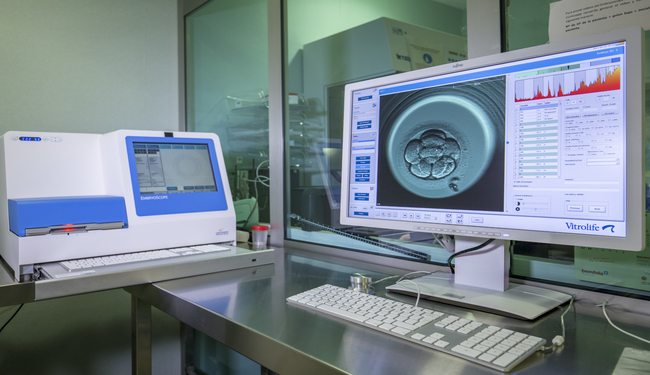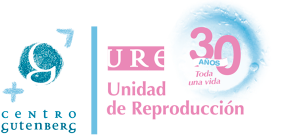Embryo classification by quality for in vitro fertilisation treatment

The biggest challenge for an in vitro fertilisation (IVF) laboratory is selecting the embryo which has the greatest potential to result in a pregnancy. That’s why today we want to explain how embryo classification works in assisted reproduction, beginning by understanding that all Spanish clinics follow the criteria for evaluation and assessment as indicated by the Association for the Study of the Biology of Reproduction (ASEBIR).
With this in mind, embryos can remain in the IVF laboratory until day +6 of embryo development, where “day zero” is the day that the eggs are retrieved and inseminated with the spermatozoids (in other words, the day of ovule collection).
Keeping in mind the above, embryo transfer to the woman’s uterus is currently performed on either day +5 or day +6 of embryo development, depending on their growth and progress.
Embryo classification according to days of embryo development
In order to understand how we classify embryos based on their quality, we must first clearly understand how they develop day by day from the very first moment they are with us in the laboratory. We will explain this next.
Day 0
As we mentioned before, day 0 is the day when the eggs are obtained during the ovule retrieval procedure and are inseminated with the spermatozoids through intracytoplasmic sperm microinjection (also known as ICSI).
Embryos on day 1
On day 1 we evaluate fertilisation. An ovule which has fertilised correctly (called a zygote), will have two pronuclei (one from the spermatozoid and the other from the egg), and two polar bodies.
Embryos on day 2-3
Between 25 and 27 hours following fertilisation the first round of cell division, or mitosis, can be observed, and afterward the embryo will continue dividing. The ideal number of cells we would like to see in an embryo is 4 cells on day 2 of development, and 8 cells on day 3.
Embryos on day 4
At this stage the cells of the embryo begin to compact and to form small unions among each other, resulting in what is known as a morula.
Embryos on day 5-6
This is the final day that the embryos are with us. At this stage the embryo becomes a blastocyst that is ready to be transferred and/or frozen through the process of vitrification. This blastocyst is uniquely structured as it has a central cavity (blastocele), and two different cell groups: the trophectoderm (which will become the placenta and non-embryo tissue), and the inner cell mass or ICM (which will make up the tissue of the embryo).
In order to better understand the process of development which is essential to classifying embryos, you can watch the following video in which the cell division we’ve just explained can be perfectly observed. What you’ll see in the video is a beautiful pregnancy captured using the EmbryoScope, a powerful time-lapse incubator which our assisted reproduction clinic was the first to use in Malaga.
Criteria that are followed for embryo classification in IVF
Now that we understand how embryos develop day by day, we’re going to explain what parameters are taken into consideration when embryos are classified.Essentially, the following factors are evaluated:
- The number of cells and their symmetry, in other words, the similarity or difference in size among the different cells in the embryo as it continues to divide.
- The rate of embryo division, and its development from the first day until day +5 or +6, the point at which a viable, properly developing embryo should reach blastocyst stage.
- The percentage and type of cell fragmentation. Fragmentation refers to tiny, leftover pieces of cells that surround the embryo. In a viable embryo, the amount of fragmentation may vary between 0 to 35 or 40 %. The problem with cell fragmentation is that these fragments may make it more difficult for the embryo to divide and develop at the proper rate. This means that the more fragmentation an embryo has, the less likely it is to result in a pregnancy.
- Morphology of the blastocyst. Blastocyst stage is the stage before embryo implantation can take place and lead to a pregnancy. The better an embryo has developed and the more favourable its appearance once it reaches blastocyst stage, the more likely it is to implant.
- Other parameters such as the presence of vacuoles, cells with more than one nucleus, and other factors such as the appearance and thickness of the external membrane which covers and protects the embryo.
How embryos are classified in IVF
Keeping in mind the criteria we have just discussed, the individual on the medical team at an assisted reproduction clinic who is responsible for monitoring and evaluating embryo development on a daily basis from the time they first fertilise is the embryologist.
The task of daily monitoring will allow the embryologist to classify the embryos and give them different grades depending on their quality:
- A quality: optimal quality embryos with maximum implantation potential.
- B quality: good quality embryos with good implantation potential.
- C quality: intermediate quality embryos with intermediate implantation potential.
- D quality: poor quality embryos with poor implantation potential.
Depending on the quality assigned to an embryo and the likelihood that it will implant, the doctor, together with the patients, will decide which embryos will be transferred and which will be cryopreserved in the event that there is more than one viable embryo with potential to result in a pregnancy. Statistically speaking, A-quality embryos are more likely to lead to a positive pregnancy test.
All embryos that are viable for embryo transfer have the ability to result in a pregnancy that goes to term and leads to a healthy baby at home. Transferring intermediate or poor quality embryos (C or D quality), does not have any impact and does not play any role in the health of the baby. Children born as a result of in vitro fertilisation treatment have the same chances of having an illness as children who were conceived naturally. It is very important to remember that having a child with an illness is not related to the quality of the embryos that are used in IVF treatment.
Additional information about embryo classification for IVF
One of the individuals with the most knowledge about embryo classification at URE Centro Gutenberg is Dr. Belén Buch, laboratory manager and embryologist at our Unit and a board member for ASEBIR.
We asked Dr. Buch a few questions about embryo classification so that you would have more information on this matter, as we appreciate that it is a topic that concerns many moms and couples who are undergoing fertility treatment.
What is the importance of embryo classification in IVF treatment?
Proper classification of the embryos obtained through in vitro fertilisation is essential to the final result of the treatment cycle. The importance of correctly evaluating and classifying embryos means that the team will be able to properly select which embryos to transfer to the uterus and/or which embryos to freeze in order to achieve a full-term pregnancy as quickly as possible.
This is why training and experience is fundamental for embryologists in the IVF laboratory seeing as embryo culture, selection and classification are the determining factors for a successful outcome, i.e. a pregnancy, in cycles of in vitro fertilisation.
Have technological advances in recent years changed the way embryos are evaluated?
Absolutely, yes. Many technological advances have been focused on reducing stress on embryos while they’re developing in the laboratory, and embryo culture equipment are becoming increasingly better adapted to what embryos need.
But the real revolution in recent years has been the emergence of incubators that monitor embryo development using cameras that are incorporated right into the incubator itself. These incubators, such as the EmbryoScope, used by URE Centro Gutenberg for the first time in all of Malaga, provide us with an enormous amount of information and are revolutionising the processes of embryo classification and selection, thus increasing success rates for certain patients. It doesn’t perform “miracles”, but it helps us and provides reassurance when it comes to justifying why we have chosen one embryo for transfer over another.
We hope this article has cleared up any doubts you had about the process of embryo classification based on quality for in vitro fertilisation treatment. If you want more information, you can take a look at different articles in our blog.

